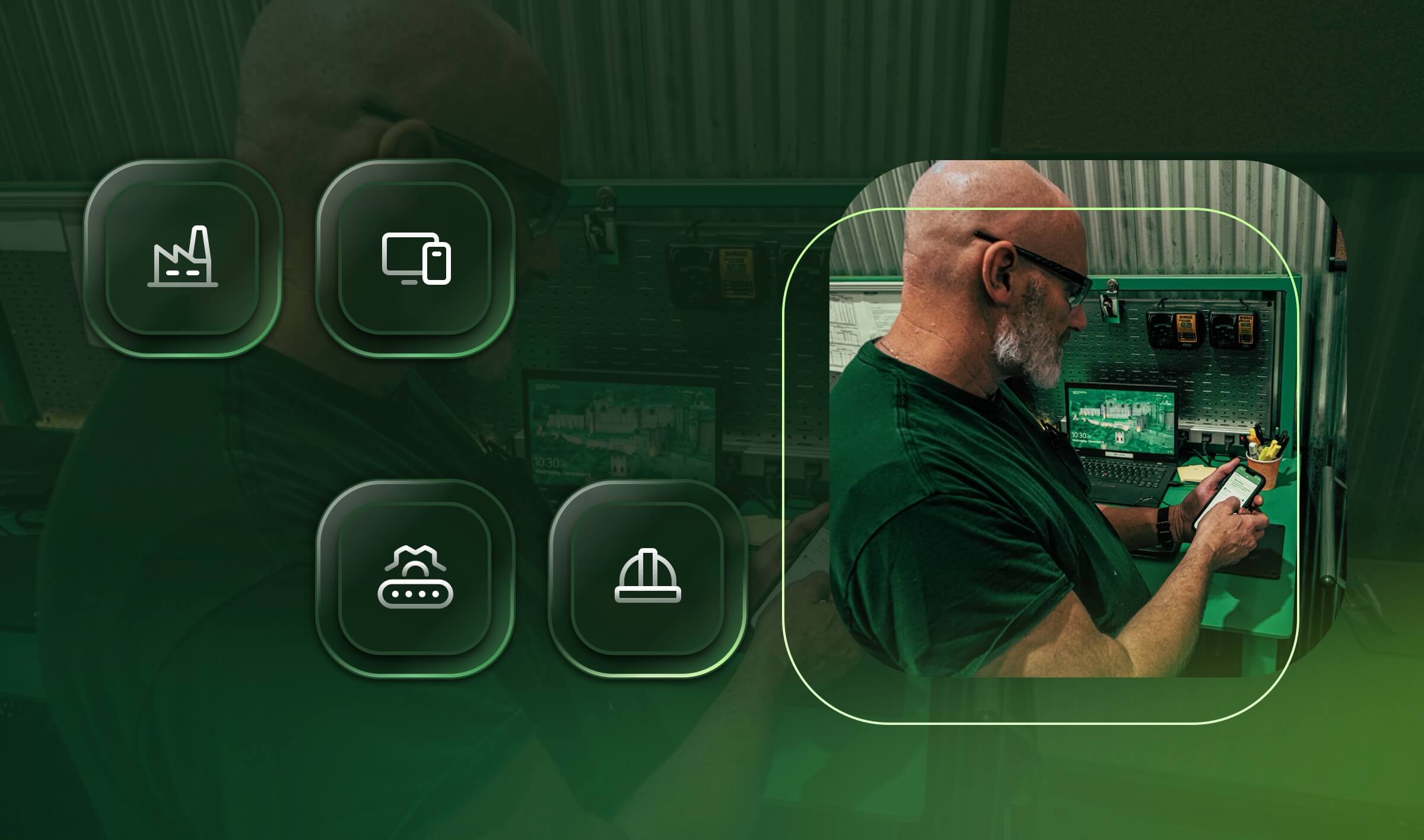
The modern factory floor is no place for stationary workstations and paper-based processes. Today's manufacturing leaders are putting powerful mobile technology directly in their teams' hands, transforming how they communicate, solve problems, and make decisions. But implementing mobile solutions isn't as simple as buying tablets and downloading apps.
Many manufacturers hit roadblocks in the implementation journey. Employee resistance slows adoption, legacy systems complicate integration, cybersecurity risks increase with new devices, and the costs of industrial-grade hardware quickly exceed budgets when poorly planned.
How do you overcome these obstacles and turn mobile technology into a true competitive advantage? In this article, we break down six proven best practices for successfully implementing mobile technology on the plant floor.
The importance of mobile technology in the manufacturing industry
Modern manufacturers are ditching clipboards and desktop terminals for devices that travel with their teams. This allows them to build connected operations that can quickly respond to both issues and opportunities.
Here's how mobile technology transforms manufacturing operations:
- Faster communication across your facility: When critical issues arise, mobile devices eliminate the need to track down team members or walk back to workstations. Instant alerts and the ability to communicate in real-time vastly speed up decision-making.
- Real-time operational efficiency: Mobile solutions put live production data in everyone's hands, right where they work. Operators log downtime reasons while standing at the machine. Maintenance technicians pull up repair histories without leaving the equipment. Supervisors adjust workflows on the spot to keep production flowing.
- Enhanced data collection and reporting: Your team captures data right when and where things happen (production counts, audits, quality checks, safety issues), all entered instantly. No more transcription errors or "I'll write it down later" problems that destroy your data integrity.
- More agile decision-making and responsiveness: When production hits a snag, you need answers now, not at next week's meeting. Mobile technology puts actionable insights in everyone's hands immediately. Your team reallocates resources, spots emerging problems, and adapts to changes the moment they happen—not after the damage is done.
Best practices for using and managing mobile devices on the plant floor
These six best practices will outline everything you need to avoid common mistakes while transforming your factory floor with mobile solutions.

1. Select appropriate mobile technology
Implementing mobile technology should be focused on solving real problems. Start by identifying your specific business objectives. Are you trying to improve maintenance response times? Streamline quality checks? Enable faster decision making?
The answers will guide your technology choices, including whether smartphones or tablets make more sense for your team. Smartphones work great for quick communication and simple data entry, while tablets shine when workers need larger screens for viewing detailed information or navigating complex systems.
Here's what to consider when choosing your devices:
- Durability: Standard consumer devices can die quickly in manufacturing settings. If needed, invest in industrial-grade hardware that handles drops, dust, chemicals, and temperature extremes.
- Battery life: Nothing kills productivity faster than running out of battery mid-shift. Choose devices that power through entire production runs or implement charging strategies.
- Ergonomic considerations: If devices are uncomfortable to carry or use, adoption will suffer. Consider weight, (screen) size, and how workers will carry the devices during their shifts.
- Compatibility: Verify compatibility with your ERP, MES, SCADA, and connected worker platform before purchase, not after deployment. Most newer devices should be able to run those types of software.
Another thing to consider is network connectivity. If your team is going to rely on mobile devices, your facility needs to have the proper wireless infrastructure to support that.
2. Ensure seamless integration
You will want to bring IT and operations together—not just at kickoff meetings, but throughout the entire project. Your IT team understands the technical requirements, while your operations team knows the workflow. You need both perspectives to avoid expensive solutions that nobody uses.
Furthermore, do not underestimate connectivity challenges. Manufacturing environments are notoriously tough on wireless signals. Conduct site surveys, invest in industrial-grade access points, and implement redundant connectivity options where critical processes depend on network access.
Test if everything works before full deployment. Start with a small area or team, gather feedback, and sort out the kinks (if any) before rolling out the mobile technology facility-wide.
3. Improve security with manufacturing mobile device management
In 2023, around a quarter of detected cyberattacks worldwide targeted the manufacturing industry. It’s a risk you shouldn’t brush aside.
The good news is that most common cybersecurity threats can be prevented by following the basics: multi-factor authentication, data encryption, and clear policies about which apps can be installed. These fundamentals go a long way.
If you're deploying more than a handful of devices, consider employing Mobile Device Management (MDM) software. MDM provides a central dashboard to control, monitor, and secure every device in your operation. You can remotely wipe lost devices, push critical updates, restrict app installations, and enforce security policies across your entire facility.
Don't leave updates to chance; incorporate these strategies:
- Establish a regular schedule for installing security patches and software updates that doesn't interfere with production.
- Create a dedicated troubleshooting process so workers know exactly what to do when devices act up.
- Treat your mobile technology like any other critical asset by implementing proper inventory control. Know what devices you have, where they are, and who's responsible for them.
4. Train your workforce
Implementing new devices gives you a fresh chance to improve and standardize internal workflows. So, before you train a single worker, update your Standard Operating Procedures (SOPs) to reflect process changes that are enabled by the mobile technology you just implemented.
Once that is ready, provide hands-on training in three key areas:
- Teach practical device usage. Don't assume digital fluency, especially with older workers. Show them how to navigate the app interfaces they need to use, troubleshoot common issues, and get help when needed.
- Show how the process has changed. Things like data entry, approvals, and issue reporting can now all be done digitally, and on the move. Show how that changes specific workflows.
- Make security awareness non-negotiable. Your team needs to understand specific threats like phishing attempts, the dangers of using public WiFi, and why downloading unauthorized apps puts production at risk. Security is everyone's responsibility.
Adoption happens gradually. You’ll want to plan for a transition period where both old and new methods run parallel, and celebrate early wins to build momentum.
5. Leverage data analytics and real-time reporting
Set up your mobile platforms to gather critical production data right at the source — downtime reasons, quality checks, maintenance activities — all captured in real time by the people closest to the work. This eliminates delay and dramatically improves accuracy compared to traditional end-of-shift reporting.
But collecting data isn't enough. Transform it into actionable insights through real-time dashboards that show what's happening right now, not what happened yesterday. Put these dashboards everywhere they matter — on supervisor tablets, mounted displays in work cells, and leadership phones. This will improve decision-making and reduce response times.
Take it a step further with predictive analytics. By analyzing patterns in your mobile-collected data, you can spot potential failures before they happen:
- Your maintenance team gets alerted to degrading equipment performance before breakdowns occur.
- Your quality team identifies emerging defect trends while they're still manageable.
- Your production team adjusts to prevent bottlenecks before they impact delivery dates.
6. Have a plan for replacing failed devices
Unlike office environments, your mobile devices are frequently exposed to heat, dust, chemicals, or physical damage. Create a practical maintenance checklist that includes:
- Inspect protective cases for cracks or wear. It’s cheaper and easier to replace the case than the whole device.
- Have a system to flag devices that do not last a full day or shift without recharging and/or experience software glitches.
- Occasionally, clean charging ports with compressed air to remove metal shavings and debris, which are one of the leading causes of charging failures.
Lastly, develop a procedure for handling device failures. Everyone on your production floor should know what to do when a device stops working: who to notify and where to get a replacement.
The future of mobile technology on the shop floor
The mobile revolution in manufacturing is just getting started. Early adopters are already experimenting with AR applications that overlay repair instructions directly on equipment, while others connect mobile devices to Industrial IoT sensor networks for unprecedented operational visibility.

AI-driven applications represent the next frontier, with predictive maintenance algorithms and adaptive interfaces converging to form interconnected ecosystems where mobile devices become the primary human interface to increasingly intelligent production environments.
The manufacturers who will thrive are those who approach mobile technology as a strategic asset rather than just another IT project. Start with these best practices today, but keep your eyes on tomorrow's emerging technologies.
How future-ready is your organization? Find out in just five minutes with L2L's FREE Digital Maturity Assessment.
Revisions
Original version: 17 July 2025
Written by: Evelyn DuJack
Reviewed by: Daan Assen
Please read our editorial process for more information
Related Posts
Subscribe to Our Blog
We won't spam you, we promise. Only informative stuff about manufacturing, that's all.



